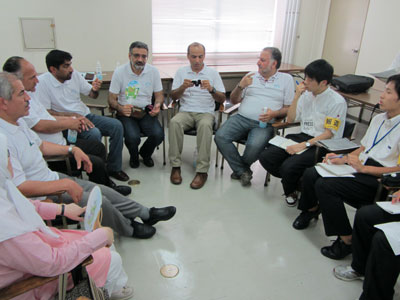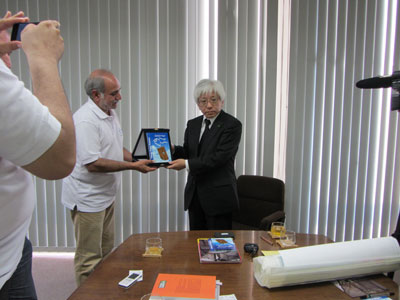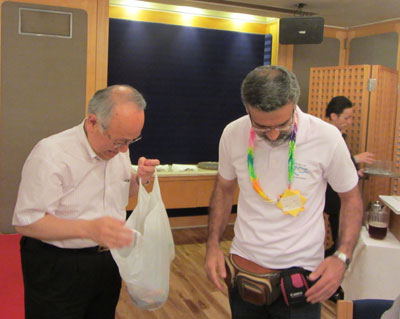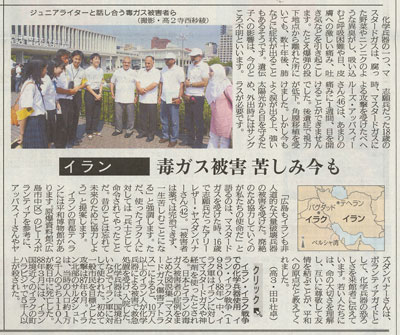Hiroshima Travelogue -Episode 13
Today, Chokogu Daily released an article reporting on our meeting with the Hiroshima Bombing survivors. Only God and, of course, the Japanese knew what the article had written about.
Officials of the daily voiced their intent to arrange a meeting between the chemically injured members of the Iranian delegation and a number of students from Hiroshima. Dr. Khateri advised me to attend the meeting.

The article about the meeting between the Iranian delegation and survivors of the Hiroshima Atomic Bombings
We headed to the daily’s newsroom. A number of students were there to voluntarily learn about journalism and the related skills. We were taken to the same room we went to in our last visit. The students had with them sheets of papers with questions in them which I couldn’t tell who had written them. Most of the questions were about the way the veterans were injured by the chemicals [during the war].
“I know that most of the people will not volunteer to participate in a war on Japan,†said one of the students in the middle of the questions and answers.

Chemically injured veterans talk with students from Hiroshima
“We are not ready to defend our country in case it is invaded,†he added. “What do you think?â€
All the attending veterans aired the same views they would if the same question was asked by a TV reporter: “We would stand till our last breath…. As much as we are still alive…†The answers were honest, but the student who asked the question was too young to have such a perception of his society, so I thought like the thing was dictated to him from grownups. “Is there a concern among Japanese grownups which has been displayed this way?†I thought I couldn’t tell.
We took pictures and they said the outcome of the meeting would be published in the papers.(1)
Today is going to be our last day in Hiroshima. They held us as many plans as they could. We met with the head of the Peace Museum. Mr. Shiga was the newly-appointed head of the museum. His grey hair was disproportionate to his age. It was hot in the meeting room. One said they wouldn’t turn the coolers on to save some energy. Mr. Shiga sat there wearing a business suit, not being irritated by the hot weather. “The museum was open until 8 p.m. yesterday and today and we had visitors,†he said.
“It is 68 years after the atomic bombings of Hiroshima and our biggest concern is that no survivors will be alive in the coming years and we should think out ways to address this issue,†he said, reiterating an issue we heard many times in those days. “The future narrators of the disaster will be no more living survivors. Will objects help us in this regard? There are thousands of objects in the museums warehouse which we will make use of?â€
Mr. Shiga spoke of various ways that the museum would keep the memory of the disaster alive. One of his sentences grabbed my attention: “We try to drop the use of the word ‘Peace’. We do not want to turn it into a useless term.â€
It can be easily inferred that the word ‘Peace’ is failing to function effectively enough to retain the memory of the disaster in a way that the immediate cultural official in the field shows worries about it. Considering the sentences by the student with Mr. Shiga’s words, I begin to realize that the Japanese have been disappointed of sailing the peace boat on the tumultuous sea of politics; it may have been effective outside, but not inside [Japan].
At the end of the meeting, Parviz Parastouei hands over the statue of Tehran Peace Museum to Mr. Shiga.

Parviz Parastouei gives Mr. Shiga a statue to remember Tehran Peace Museum
This is our last night in Hiroshima. Our kind hosts prepared for another event for us to remember our stay in the city; dinner at Hans Christian Andersen Hotel. We went upstairs where four large round tables awaited us. As usual, every one of the guests should say something in such gatherings. I tried to find a paper to write on but I failed. I suddenly saw Japanese chopsticks wrapped in papers. On unwrapped them and wrote on its white back: “I am happy to be present in a meeting held to address life; not life, higher than life; how to live; even more, how to think. We shall think to reach human dignity; to shun human mischief.â€
Morteza Sarhangi beckoned me to pass over the paper to him. He added this to my statement: “I thank you for all the smiles and kindness. Wishes and the ways to reach them are both beautiful. Tonight is August 6. I wish your city, Hiroshima, will become a cradle for nurturing peace on the planet of pain.â€

It is written on it: “Smile helps the world!â€
We read the statements on our turns. There came Professor Inaei with a plastic sack in his hand full of presents. He gave every Iranian visitor a hand-made necklace. Nationals from around the world had made the objects and sent them to Hiroshima. Tens of origami cranes standing for Sodako (name of a girl who became a symbol of innocent victims of war) formed a string around our necks. Mr. Inaei hanged one of them on my neck. On it was written with pen: Smile helps the world.
1- It is published; fall 2013. Moct came to Iran. Ms. Soya was there too. Among the presents that she had brought, there was an issue of this paper with that news item in it.

Hedayatollah Behboudi
Translated by: Abbas Hajihashemi
Number of Visits: 5365








The latest
- Oral History News of Khordad 1404 (May 22nd – June 21st 2025)
- Najaf Headquarters Human Resources
- The Embankment Wounded Shoulders – 12
- Annotation
- The 367th Night of Memory– 5
- The Founder of Hosseiniyeh Ershad
- The Embankment Wounded Shoulders – 11
- The Role of the Bazaaris in the Final Days of the Islamic Revolution
Most visited
Memoirs of Hujjat al-Islam Reza Motalebi
Hujjat al-Islam Reza Motalebi is a cleric from Isfahan. Before the revolution, he was the imam of the Fallah Mosque – which was later renamed Abuzar Mosque. By his presence and efforts, Abuzar Mosque soon became a base for supporters of the Imam and the revolution. After the victory of the revolution, he played a role in uniting forces and maintaining political vitality in southwest Tehran.The Necessity of Receiving Feedback in Oral History
Whenever we engage in a task, we naturally seek ways to evaluate our performance — to correct shortcomings and enhance strengths. Such refinement is only possible through the feedback we receive from others. Consider, for instance, a basketball player whose shots are consistently accurate; should he begin shooting blindfolded, his success rate would rapidly decline, as he would be deprived of essential feedback from each attempt.Sir Saeed
The book “Sir Saeed” is a documentary [narrative] of the life of martyr Seyyed Mohammad Saeed Jafari, written by Mohammad Mehdi Hemmati and published by Rahiyar Publications. In March 2024, this book was recognized as one of the selected documentary biographies in the 21st edition of the Sacred Defense Book of the Year Award. The following text is a review on the mentioned book.Morteza Tavakoli Narrates Student Activities
I am from Isfahan, born in 1336 (1957). I entered Mashhad University with a bag of fiery feelings and a desire for rights and freedom. Less than three months into the academic year, I was arrested in Azar 1355 (November 1976), or perhaps in 1354 (1975). I was detained for about 35 days. The reason for my arrest was that we gathered like-minded students in the Faculty of Literature on 16th of Azar ...

